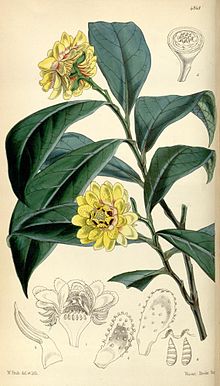Eupomatiaceae
| Eupomatia | |
|---|---|
 |
|
|
Eupomatia bennettii 1855 illustration |
|
| Scientific classification | |
| Kingdom: | Plantae |
| Clade: | Angiosperms |
| Clade: | Magnoliids |
| Order: | Magnoliales |
| Family: |
Eupomatiaceae Orb. |
| Genus: |
Eupomatia R.Br. |
| Species | |
Eupomatia is a genus of three flowering shrub species known to science, of the Australian continent ancient family Eupomatiaceae. The Eupomatiaceae have been recognised by most taxonomists and classified in the plant order Magnoliales. The three species of shrubs or small trees grow naturally in the rainforests and humid eucalypt forests of eastern Australia and New Guinea. The type species Eupomatia laurina was described in 1814 by Robert Brown.
Protogynous and autocompatible flowers, with a reduction in selfing through herkogamy, diurnal synchronization of anthesis and the tendency of the same plant to not flower on two consecutive days. Anthesis lasts one or two days, at the height the flower behaves functionally as a female, showing its gynoecium and with open staminodes, while the stamens remain below the flower. The flower later behaves as a male with the intrastaminal staminodes folded inwards hiding the gynoecium and with erect stamens. The staminodes secrete an oily exudate and emit a fruity smell that attracts beetles, particularly of the genus Elleschodes (Curculionidae), that visit the flowers in both phases, in addition the synandria fall to the ground (cantharophily pollination). The fruit is sweet and aromatic and it is dispersed by birds and mammals (zoochory). The fruit is also eaten by humans.
The species are native to the tropical habitats of the rain forest, from sea level to an altitude of 1,300 m.
...
Wikipedia
